View in other NatureServe Network Field Guides
NatureServe
Montana
Utah
Wyoming
Idaho
Wisconsin
British Columbia
South Carolina
Yukon
California
New York
Alpine Sagebrush - Artemisia scopulorum
Native Species
Global Rank:
G4G5
State Rank:
S4
(see State Rank Reason below)
C-value:
Agency Status
USFWS:
USFS:
BLM:
External Links
State Rank Reason (see State Rank above)
Artemisia scopulorum occurs in southwest Montana where it can be common at higher elevations and in alpine habitats. It seems to occur in undisturbed areas.
- Details on Status Ranking and Review
Range Extent
ScoreE - 5,000-20,000 sq km (~2,000-8,000 sq mi)
Area of Occupancy
ScoreE - 26-125 4-km2 grid cells
Number of Populations
ScoreD - 81 - 300
Number of Occurrences or Percent Area with Good Viability / Ecological Integrity
ScoreC - Few (4-12) occurrences with excellent or good viability or ecological integrity
Environmental Specificity
ScoreC - Moderate. Generalist or community with some key requirements scarce
Threats
ScoreD - Low
CommentNo known threats.
General Description
PLANTS: Gray-green herbaceous perennials that grow from a branched caudex (Lesica et al. 2006). Stems ascending to erect, 5–20 cm. Plants are mildly-aromatic (FNA 2006) and strigose to canescent.
LEAVES: Basal and cauline blades are petiolate, 1–3 cm mm long, ovate, twice pinnately lobed into linear-oblanceolate segments; cauline blades are few and reduced in size (Lesica et al. 2006).
INFLORESCENCE: Spiciform to racemose with lobed bracts (Lesica et al. 2012). 5-22 heads in spiciform arrays, 5-9 cm by 1-1.5 cm (FNA 2006).
Phenology
Plants flower in mid- to late summer (FNA 2006).
Species Range
Montana Range
Range Descriptions
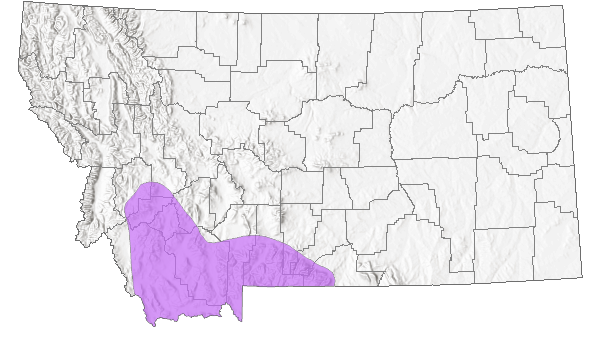
 Native
Native
Range Comments
Colorado, Montana, Nevada, New Mexico, Utah, and Wyoming (FNA 2006).
Observations in Montana Natural Heritage Program Database
Number of Observations: 123
(Click on the following maps and charts to see full sized version)
Map Help and Descriptions
Relative Density
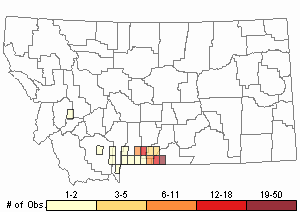
Recency
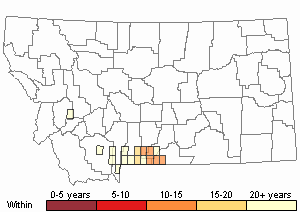
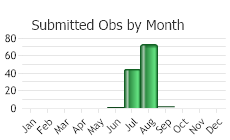
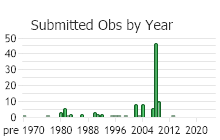
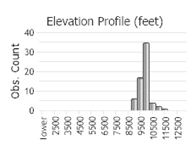 (Observations spanning multiple months or years are excluded from time charts)
(Observations spanning multiple months or years are excluded from time charts)
Habitat
Stony, non-calcareous soil of turf, and fellfields in the alpine (Lesica et al. 2012). At elevations from 3,100 to 4,200 meters (FNA 2006).
Ecology
Sagebrush in general is adapted to climates with cold winters where most precipitation falls in the winter (Meyer 2008). Shrubs in the genus Artemisia are important winter browse for ungulates (Meyer 2008). This species relies on wind for pollination and seed dispersal (Meyer 2008). Each seed is enclosed in a papery pericarp. The pericarp has mucilaginous nerves that may help the seed stick to the soil while its root penetrates (Meyer 2008).
Reproductive Characteristics
Flowers (heads): Involucres are hemispheric, 3–4 mm high; phyllaries have black margins with green centers and are densely villous (Lesica et al. 2012). The receptacle is villous. 20 to 45, perfect or female only disk flowers have yellow with purple, villous tips and corollas of 2 mm length (Lesica et al. 2012). Achenes are about 1 mm long and glabrous (Lesica et al. 2012).
Stewardship Responsibility
References
- Literature Cited AboveLegend:
 View Online Publication
View Online Publication Flora of North America Editorial Committee. 2006. Flora of North America North of Mexico. Vol. 19. Magnoliophyta: Asteridae, part 6: Asteraceae, part 1. Oxford Univ. Press, New York. xxiv + 579 pp.
Flora of North America Editorial Committee. 2006. Flora of North America North of Mexico. Vol. 19. Magnoliophyta: Asteridae, part 6: Asteraceae, part 1. Oxford Univ. Press, New York. xxiv + 579 pp. Flora of North America Editorial Committee. 2006. Flora of North America North of Mexico. Vol. 20. Magnoliophyta: Asteridae, part 7: Asteraceae, part 2. Oxford Univ. Press, New York. xxii + 666 pp.
Flora of North America Editorial Committee. 2006. Flora of North America North of Mexico. Vol. 20. Magnoliophyta: Asteridae, part 7: Asteraceae, part 2. Oxford Univ. Press, New York. xxii + 666 pp. Lesica, P., M.T. Lavin, and P.F. Stickney. 2012. Manual of Montana Vascular Plants. Fort Worth, TX: BRIT Press. viii + 771 p.
Lesica, P., M.T. Lavin, and P.F. Stickney. 2012. Manual of Montana Vascular Plants. Fort Worth, TX: BRIT Press. viii + 771 p. Meyer, S.E. 2008. Artemisia L. in Bonner, F.T. and R.P. Karrfalt. The Woody Plant Seed Manual. Agric. Handbook No. 727. Washington, DC: USDA, Forest Service. 1223 p.
Meyer, S.E. 2008. Artemisia L. in Bonner, F.T. and R.P. Karrfalt. The Woody Plant Seed Manual. Agric. Handbook No. 727. Washington, DC: USDA, Forest Service. 1223 p.
- Additional ReferencesLegend:
 View Online Publication
View Online Publication
Do you know of a citation we're missing? Aho, Ken Andrew. 2006. Alpine and Cliff Ecosystems in the North-Central Rocky Mountains. Ph.D. Dissertation. Bozeman, Montana: Montana State University. 343 p.
Aho, Ken Andrew. 2006. Alpine and Cliff Ecosystems in the North-Central Rocky Mountains. Ph.D. Dissertation. Bozeman, Montana: Montana State University. 343 p. Jones, W. W. 1901. Preliminary flora of Gallatin County. M.S. Thesis. Bozeman, MT: Montana State College. 78 pp.
Jones, W. W. 1901. Preliminary flora of Gallatin County. M.S. Thesis. Bozeman, MT: Montana State College. 78 pp. Lesica, P., M.T. Lavin, and P.F. Stickney. 2022. Manual of Montana Vascular Plants, Second Edition. Fort Worth, TX: BRIT Press. viii + 779 p.
Lesica, P., M.T. Lavin, and P.F. Stickney. 2022. Manual of Montana Vascular Plants, Second Edition. Fort Worth, TX: BRIT Press. viii + 779 p. Martin, S.A. 1985. Ecology of the Rock Creek bighorn sheep herd, Beartooth Mountains, Montana. M.Sc. Thesis. Bozeman, MT: Montana State University. 152 p.
Martin, S.A. 1985. Ecology of the Rock Creek bighorn sheep herd, Beartooth Mountains, Montana. M.Sc. Thesis. Bozeman, MT: Montana State University. 152 p. Osmundson, T.W. 2003. Systematics of Rocky Mountain alpine Laccaria (basidiomycota, agaricales, tricholomataceae) and ecology of Beartooth Plateau alpine macromycetes. M.Sc. Thesis. Bozeman, MT: Montana State University. 188 p.
Osmundson, T.W. 2003. Systematics of Rocky Mountain alpine Laccaria (basidiomycota, agaricales, tricholomataceae) and ecology of Beartooth Plateau alpine macromycetes. M.Sc. Thesis. Bozeman, MT: Montana State University. 188 p. Pallister, G.L. 1974. The seasonal distribution and range use of bighorn sheep in the Beartooth Mountains, with special reference to the West Rosebud and Stillwater herds. M.Sc. Thesis. Bozeman, MT: Montana State University. 67 p.
Pallister, G.L. 1974. The seasonal distribution and range use of bighorn sheep in the Beartooth Mountains, with special reference to the West Rosebud and Stillwater herds. M.Sc. Thesis. Bozeman, MT: Montana State University. 67 p. Parks, J.C. 1986. Plant materials for use on disturbed alpine areas in Montana. M.Sc. Thesis. Bozeman, MT: Montana State University. 57 p.
Parks, J.C. 1986. Plant materials for use on disturbed alpine areas in Montana. M.Sc. Thesis. Bozeman, MT: Montana State University. 57 p. Stewart, S.T. 1975. Ecology of the West Rosebud and Stillwater bighorn sheep herds, Beartooth Mountains, Montana. M.Sc. Thesis. Bozeman, MT: Montana State University. 130 p.
Stewart, S.T. 1975. Ecology of the West Rosebud and Stillwater bighorn sheep herds, Beartooth Mountains, Montana. M.Sc. Thesis. Bozeman, MT: Montana State University. 130 p. Williams, K.L. 2012. Classification of the grasslands, shrublands, woodlands, forests and alpine vegetation associations of the Custer National Forest portion of the Beartooth Mountains in southcentral Montana. M.Sc. Thesis. Bozeman, MT: Montana State University. 376 p.
Williams, K.L. 2012. Classification of the grasslands, shrublands, woodlands, forests and alpine vegetation associations of the Custer National Forest portion of the Beartooth Mountains in southcentral Montana. M.Sc. Thesis. Bozeman, MT: Montana State University. 376 p.
- Web Search Engines for Articles on "Alpine Sagebrush"





